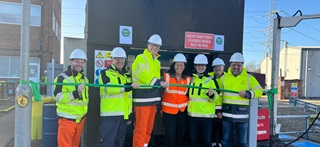Brazil: Electrifying the fleet for a greener future
Brazil, Supergasbras is working to make its vehicle fleet more sustainable by converting 50 diesel trucks used in cylinder direct sales to electric trucks, with the aim of reducing 645 tonnes of carbon dioxide equivalents (CO2e) per year.
Currently, 50 electric trucks represent 7.5% of the total Supergasbras fleet in Brazil, and 39% of the cylinder fleet. The Cylinder Direct Sales channel was selected to receive electric trucks as the load capacity fits the needs of this channel plus the shorter distances needed to deliver LPG to customers.
In addition, Supergasbras has one electric bulk truck, which has been in use for more than 24 months. Before starting this pilot test engineering, operations and S&S areas formed a working group for the test, supported by a number of third-party companies. These actions are being repeated for the cylinder trucks.
"This initiative shows our commitment to innovation, ensuring that we are aligned with best practices and contributing to a low-carbon future."
Claudio Azevedo dos Santos
Supply Chain Director, Supergasbras, Brazil
United Kingdom: Embracing HVO diesel for sustainable transport
Hydrotreated vegetable oil (HVO) is a sustainable, drop-in alternative to diesel, reducing net CO2 emissions by up to 90%. It also improves air quality by lowering particulate matter (PM) and nitrogen oxide (NOx) emissions without requiring after-treatment.
In November 2024, Calor GB launched HVO across 12 bunkered fuel sites for all post-2017 plated vehicles. The HVO is supplied by Crown Oil, which sources 100% biodegradable (made from certified waste), ISCC-certified fuel, mainly from the United States, and ensures each delivery is carbon-tested. In year one, Calor GB expects to save up to 9,000 tonnes of CO2e across Scope 1 and Scope 3 GHG emissions.
"Fleet emissions make up a large portion of our carbon footprint, and switching to HVO will make a real difference."
Kelly Bailey
Corporate Responsibility Manager, Calor, GB
India: Pioneering CNG trucks to reduce carbon footprint
India-based SUPERGAS is boldly targeting a 42% reduction in its Scope 1 and 2 GHG emissions over 2023-27, while also exploring how Scope 3 emissions can be reduced with new initiatives. To help meet this ambitious goal, in 2023 the business began transitioning its LPG fleet from diesel to compressed natural gas (CNG) trucks.
The difference has been remarkable. In 2024, SUPERGAS our 237 diesel vehicles covered 9.6 million kilometres, producing 3,395 tonnes of CO2e. In contrast, 12 CNG vehicles belonging to the business travelled 0.35 million kilometres, emitting just 105 tonnes. This prevented the emissions of 12.75 tonnes of CO2e, equivalent to the annual carbon capture of approximately 15 acres of forest.
Currently, CNG vehicles represent just 4.8% of the SUPERGAS cylinder transportation fleet, but the business aims to increase this to 20% by 2028.
"When you are covering nearly 10 million kilometres annually, even small changes have a significant impact."
Sai Kumar Adala
Senior Manager - Logistics, SUPERGAS, India





 }
}
 }
}
 }
}
 }
}